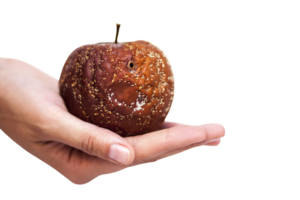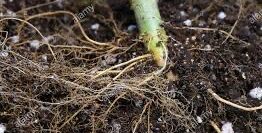 Thanks to a trace mineral nutrient deficiency in the soil, we have been seeing stunted growth in many of our crops for over a hundred years. In fact it wasn’t until the 1930s when Harry Olsen and Frank Smith discovered these were essential nutrients that plants needed for optimum growth.
Thanks to a trace mineral nutrient deficiency in the soil, we have been seeing stunted growth in many of our crops for over a hundred years. In fact it wasn’t until the 1930s when Harry Olsen and Frank Smith discovered these were essential nutrients that plants needed for optimum growth.
We know that trace elements which plants need such as iron, zinc, magnesium and selenium are essential for health and play important roles in plant growth, but they are also an excellent set of indicators for soil fertility levels – if trace elements such as these are lacking or missing altogether then its likely that other nutrient levels will be low too.
Plants cannot grow without trace elements nor can humans maintain good health so it’s no wonder that there is a growing deficiency in overall human health in the US and worldwide.
Understanding mineral deficiencies starts with knowing that these primary nutrients are very responsive to changes. They are more affected by environmental conditions such as excess or lack of air moisture, temperature, pH level and insects than they are by drought.
Generally we consume trace minerals through foods (common sources include meat, fish, dairy, cereals and tea) but these mineral levels vary significantly.
 Levels in plants that have been grown organically are higher than those of their counterparts grown with chemical fertilizers which contain trace element depletion or which have trace element concentration levels low enough to impede growth; but even still, these nutrients from organic sources differ between batches and crop.
Levels in plants that have been grown organically are higher than those of their counterparts grown with chemical fertilizers which contain trace element depletion or which have trace element concentration levels low enough to impede growth; but even still, these nutrients from organic sources differ between batches and crop.
Traditional farming practices used to involve soil amendments such as composts or cover crops, whereas modern agriculture is more dependent on artificial fertilizers containing trace elements at very precise concentrations and a high amount of NPK for compensation – lab engineered fertilization if you will.
Ultimately this causes trace element deficiencies in soils when they are used too frequently over time: a nutrient treadmill effect that strips the earth of the trace nutrients that plants (and animals, including humans) require.
These nutrients can also be found in organically grown produce, but they are not absorbed by the plants as well as conventional fertilizers due to their low nutrient content and reduced pH levels (acidic soil).
 Some organic fertilizers used on crops may actually strip these nutrients from the plant’s tissues because they’re coming from organic sources that differ between batches and crop.
Some organic fertilizers used on crops may actually strip these nutrients from the plant’s tissues because they’re coming from organic sources that differ between batches and crop.
To better understand this issue we must also look at how trace minerals work with other nutrients: For example, calcium is only able to bind with phosphorus if it has adequate mineral support.
What’s more, trace minerals are required for healthy microbe health, microbes that plants also rely on for their own health and growth.
By using these nutrients we can improve both the quality and quantity of our crops while maintaining or improving soil health. All this means better yields, higher quality produce and even happier consumers.
 Trace minerals build enzymes which regulate cellular functions necessary for optimum growth enabling plants to absorb sunlight energy through photosynthesis. These minerals are also are part of many other cellular functions such as photosynthesis, water absorption and distribution, oxygen production through the processes of respiration and metabolism.
Trace minerals build enzymes which regulate cellular functions necessary for optimum growth enabling plants to absorb sunlight energy through photosynthesis. These minerals are also are part of many other cellular functions such as photosynthesis, water absorption and distribution, oxygen production through the processes of respiration and metabolism.
Only trace amounts (parts per million) of trace minerals are required for good growth but optimum health requires that trace minerals be present in very large amounts (as much as 10% or more).
Trace minerals plants need for growth and staying healthy can be found in compost made from trace mineral-rich materials like sea weed or rock dust, but with today’s modern farming methods, trace minerals have been depleted from farm soils. This leaves farmers with a challenge to find trace minerals to replenish their soils.
Trace minerals are trace amounts of minerals that plants need to grow and stay healthy. In hair analysis testing, trace minerals are often among the most deficient trace elements in most people’s bodies these days. One reason is because soluble forms of these minerals have been leached from the soil into our water supply by modern farming methods.
 The trace minerals are in the dirt. Soil is a good thing to look for them. The elements of the trace minerals that are essential for plant growth include boron, copper, iron, manganese molybdenum and zinc. Depending on the soil type, there may be up to 14 trace minerals required for optimal plant growth.
The trace minerals are in the dirt. Soil is a good thing to look for them. The elements of the trace minerals that are essential for plant growth include boron, copper, iron, manganese molybdenum and zinc. Depending on the soil type, there may be up to 14 trace minerals required for optimal plant growth.
At one time trace minerals replenished themselves naturally in the ground through volcanic activity and earth movement (plates shifting), as well as decaying organic matter. This process kept nutrients cycling and thus became part of the natural life cycle of plant species.
Certain organic fertilizers like Mineral-Gro contain these trace minerals that plants need for their health, and the difference between plants grown with this organic fertilizer vs those grown on land with high NPK and low mineral concentration is easy to see (and taste).
The following are some of the most important trace minerals for plants and they are traceable in our foods:

Boron deficiency in plants initially shows as fruit (particularly apples and grapes) that are smaller than average with a very thin skin.
While mineral elements are needed in trace amounts, they still play a key role in many vital plant processes and the various role they play is sometimes very subtle. Though not as apparent to the human eye, trace minerals provide plants with energy and maintain metabolic functions within cells. They also help plants grow strong roots that can keep them stable during drought and add resistance to pests or disease even when grown organically.

As a result of all of this, trace minerals are considered as important or more-so than nitrogen in terms of pro
duction.
This is because trace minerals provide the plant with energy, and without it they die. With nutrient deficient roots will not be able to anchor plants, and depending on the deficiency—there can be varying degrees of damage to the plant. For example, nutrient deficiencies can cause apical dominance which results in plants growing tall but thin instead of wide and bushy. However nutrient deficiencies rarely kill entire plants outright though some do occur when certain trace elements are lacking.
As for humans… essential minerals function directly within our body because we need them just as much – if not more –than plants do.
It can be difficult to get these trace minerals into our diet. Sure, they can be readily found in unrefined sea salt and similar products, but what we need is produce made in mineral rich soil. Modern day processed food manufacturers will often use synthetic trace mineral replacements instead of the real thing which can have disastrous results on human health particularly for those with poor digestion.
For example, nutrient deficiency related cardiovascular issues include heart palpitations, angina, and tachycardia. The trace mineral chromium is important in the regulation of blood sugar levels with a deficiency leading to glucose intolerance.
 Deficient nutrient intake results in nutritional imbalances that can cause a range of physical symptoms such as hair loss, reduced immunity (increased susceptibility to infection), fatigue, poor stress tolerance, periodic mood swings and depression. A lack of trace minerals also contributes to the development of osteoporosis whereby the bones are less able to contain calcium allowing it to escape into the blood stream where it impairs normal cell function.
Deficient nutrient intake results in nutritional imbalances that can cause a range of physical symptoms such as hair loss, reduced immunity (increased susceptibility to infection), fatigue, poor stress tolerance, periodic mood swings and depression. A lack of trace minerals also contributes to the development of osteoporosis whereby the bones are less able to contain calcium allowing it to escape into the blood stream where it impairs normal cell function.
· Enlarged prostate and colon polyps.
· Lung cancer (if trace minerals are deficient then cancer cells can´t be killed by the body´s immune system)
· Increased risk of heart disease, atherosclerosis, blood clots, high blood pressure and stroke.
· Osteoporosis
· Diabetes mellitus
· Hypoglycemia and loss of energy.
So, it is not always possible to tell that nutrient deficiency is present just through blood testing. Indeed some trace minerals can only be measured accurately through hair analysis.
Plants in nature require essential trace elements for optimum growth and development—but many modern agricultural practices concentrate on maximising yields with little regard given to mineral content when choosing crops and livestock feedstuffs. This has resulted in plants containing trace minerals becoming increasingly difficult to source which means a natural diet also becomes deficient in trace minerals.
For years, trace minerals have been known as the “invisible micronutrients” or trace elements for plants.
Our premium organic fertilizer contains up to 78 essential trace needed by plants in ratios that closely match that found in soils growing our native crops before heavy metal contaminated the soil with lead, cadmium and other toxic metals.
Trace elements cannot be made in a lab, so when you choose to purchase our Mineral-Gro Organic Fertilizer you are getting is a rich source of naturally occurring trace nutrients mined from natural deposits around the world.
We then micron-size these minerals in a vortex chamber using compressed air and resonating frequencies, turning them into a concentrated, micron-sized dry powder. From there, we send the micronized minerals through a liquid mixing process that nano-sizes them in a solution—a liquid fertilizer that’s ready to be diluted and applied directly to the soil or sprayed right onto your plants.
Subscribe to get our great promotions and discounts weekly